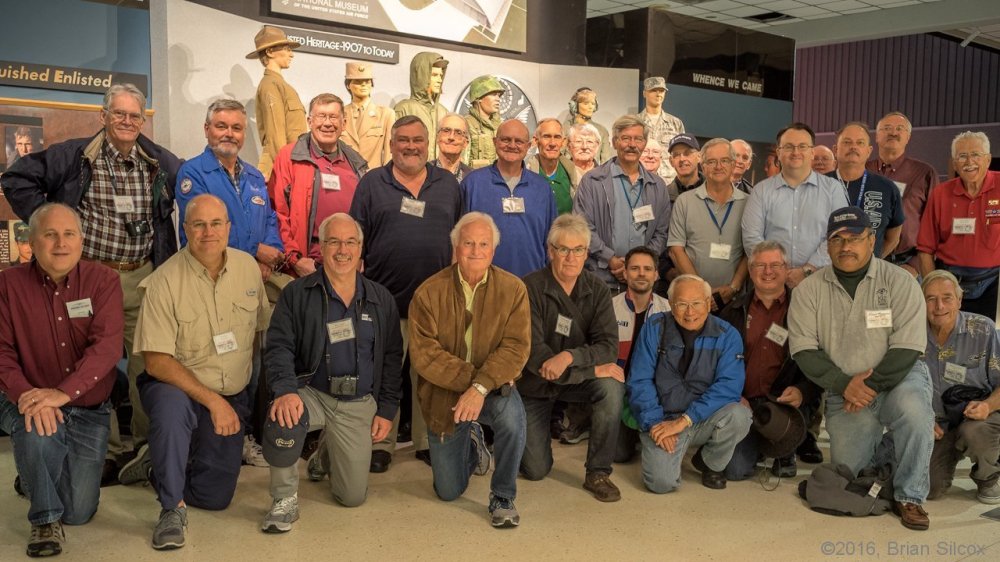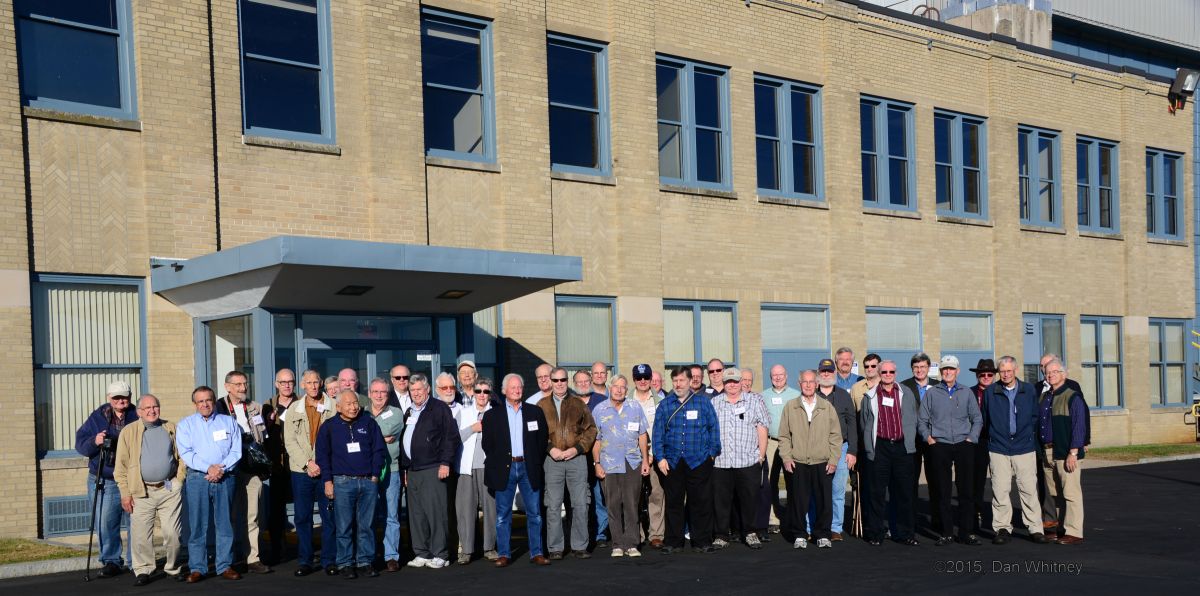
Photo Courtesy of Brian Silcox
(click for a larger image)
AEHS Convention Highlights
2016 Convention
Report from 13th Annual AEHS Convention
Dayton, Ohio (September 27 - 30, 2016 )
by Kimble D. McCutcheon
Program
 |
| 2016 Convention Attendees inside the National Museum of the United States Air Force Photo Courtesy of Brian Silcox (click for a larger image) |
Sixty persons attended the 2016 AEHS Convention, which was held in Dayton, Ohio. This thirteenth annual convention celebrated the National Museum of the United States Air Force WWI Dawn Patrol Rendezvous and opening of the new fourth building, which houses experimental, transport and presidential collections. It was the second Dayton convention, the first being held in 2007. It was also the first NMUSAF visit for several Members.
Distribution of name badges and programs began at 1400 on Tuesday, 27 September and continued through the afternoon. Many attendees used this opportunity to meet and greet others, catching up on news since the last convention. The festivities continued during the reception and well into the evening.
Wednesday was devoted to visiting the NMUSAF. After assembling inside for a group photograph (it was raining outside), everyone dispersed to tour the facility at their leisure.
The Thursday technical sessions covered a rich variety of topics.
• Kip Lankenau described the state of world industry, transportation and culture at the turn of the 20th century. He then followed the rise of aviation and early aero engines, giving several examples of the engines and their makers.
• Calum Douglas presented highlights from his upcoming book that explores Allied versus Axis boosting technology and development during WWII. Calum has gained access to the previously unpublished work of Dr. Ing-Karl Kollmann, Chief Designer at Daimler-Benz AG -Stuttgart Unterturkheimhttps, and has translated this work for his book. His presentation was a fascinating technology comparison that explored numerous engine design and construction aspects.
• Jeremy Kinney treated the group to a preview of his upcoming book Reinventing the Propeller: Aeronautical Specialty and the Triumph of the Modern Airplane. His talk concentrated on U.S., British and German propeller development and use before and during WWII.
• After lunch, Larry Rinek discussed the background, development, production and operation of the Convair B-36 Peacemaker.
• David Newill introduced the New Rolls-Royce Heritage Trust Allison Branch Museum and outlined challenges the R-RHT, AB volunteers have faced during relocation of its exhibit space, shop and archives.
• Tom Fey informed us about bi-directional aircraft engines, an interesting class of engines that featured both rotating cylinders and crankshafts, some with contra-rotating propellers. Tom has identified over 19 of these oddities.
The technical sessions were followed by the traditional banquet buffet, after which Tony Wytenburg shared his experiences with reverse-engineering, machining, testing and flying brand new Gnome 9-cylinder rotary engines.
Friday morning was devoted to a visit to the NMUSAF Restoration and Storage Facility. The B-17F Memphis Belle that we saw in 2007 has made significant progress; the center section has been reinstalled as has its engines and it is now on its gear. Restoration of the B-17D Swoose is also proceeding, but judging from the amount of new parts being fabricated, it has a long way to go.
All presentations are in the AEHS Members' Section under AEHS Conventions.
Several AEHS Members stuck around into Saturday to visit the NMUSAF Dawn Patrol event, which included several runs of Tony Wytenburg's Gnome.
More 2016 Convention Coverage in the Members Section
2015 Convention
Report from 12th Annual AEHS/SARH Convention
Windsor Locks, Connecticut (October 13 - 16, 2015 )
by Kimble D. McCutcheon
Program
 |
| 2015 Convention Attendees in Front of the Pratt & Whitney Museum Entrance Photo Courtesy of Dan Whitney (click for a larger image) |
Just before the 2014 Convention began, I got a call from Society of Air Racing Historians (SARH) President Tim Weinschenker suggesting a joint AEHS/SARH meeting in 2015. He wanted this meeting to be held near the New England Air Museum (NEAM) and to celebrate the restoration of Anson Johnson's radically modified North American P-51 N13Y. It seemed to me that if we had this meeting in mid-October it would give NEAM the maximum amount of time to complete N13Y's restoration and would also put the group in New England at the fall foliage peak. After consulting Al Charlievios and Pat Sidley, a couple of NEAM volunteers and Connecticut natives, we set the date of October 13 - 16 for the AEHS/SARH Twelfth Annual Convention, and started making arrangements.
Registration began around noon on Tuesday 13 October. This informal registration is always one of my favorite activities, as attendees trickle in and pick up their programs. Many stick around for the afternoon, meeting new people, renewing old acquaintances, and for course, talking about engines. A total of 62 persons signed up for the Convention; 60 actually attended. The social setting continued far into the evening reception as attendees munched hors d'oeuvres, sipped drinks and talked racing airplanes, warbirds, and engines.
Wednesday was devoted to technical sessions. Larry Rinek started the day off with a spirited presentation, Menasco Aircraft Engines and Their Air Racing Heritage. Larry once worked for Menasco and the fondness he still holds for the company is obvious.
Next up was Fred van der Horst, who traveled from the Netherlands to talk of Hispano-Suiza A - Z. As with all of Fred's presentations, this one was extremely well researched and informative.
Larry Rinek, Joe Stamm, Jim Wronkiewicz, Dan Whitney and Tom Nallen provided videos, some of which were screened during lunch. The rest were screened at the end of the day on Wednesday, Thursday, and Friday; everyone seemed to enjoy these.
At the conclusion of lunch, SARH President Tim Weinschenker and SARH Newsletter Editor Joe Stamm presented Unlimited Class Air Racing in the 1940s: A History of People and Technology. I learned a lot from this presentation, which sketched the history of U.S. air racing, its innovators, and the enabling technologies that pushed it forward.
To close out the day, Randy Huff and I discussed The Genesis of American Air-Cooled Fixed Radials, which dealt with the process by which American radial engines became reliable. Randy has been creating aircraft engine CAD models for the last several years; he talked of the process by which he creates these models from scant technical information. Some of his models are realized as working 3D scale engine cutaways.
The group traveled to East Hartford on Thursday to visit the Pratt & Whitney Museum and Customer Training Center (CTC). The Museum houses nearly all of P&W's experimental engines, some of which were on display. The CTC features several current-production P&W gas turbines, and numerous disassembled components. These are used to train maintenance personnel.
On Thursday evening, Kevin Cameron summarized his nearly two-decade study of the technical and political factors behind high Boeing B-29 non-combat loss rates. The sobering Aspects of the R-3350/B-29 Experience caused lots of gasps and head shaking. A question and answer session followed, as did more videos.
Our Friday visit to the NEAM was a great experience for everyone. Anson Johnson's N13Y had been rolled into the main display hangar. The NEAM volunteers have done a fine restoration job. Attendees had close-up access to the engine collection, several aircraft cockpits, the restoration facility, and the storage facility.
The 2015 Convention ended on Friday evening with a banquet, followed by Tony Vasko's humorous tales of life as an airline maintenance mechanic. Engines from a Maintenance Mechanic's Perspective left everyone in a cheery mood as they said their goodbyes 'til next year.
SARH Presentation
Tim Weinschenker and Joe Stamm - Unlimited Class Air Racing in the 1940s: A History of People and Technology, Part 1 (5.9M PDF)
Tim Weinschenker and Joe Stamm - Unlimited Class Air Racing in the 1940s: A History of People and Technology, Part 2 (5.3M PDF)
The J58 Start Cart, by Tom Fey
More 2015 Convention Coverage in the Members Section